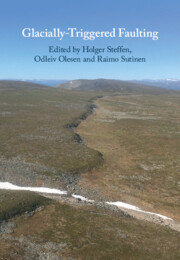Book contents
- Glacially-Triggered Faulting
- Glacially-Triggered Faulting
- Copyright page
- Contents
- Figures
- Tables
- Contributors
- Preface
- Part I Introduction
- Part II Methods and Techniques for Fault Identification and Dating
- 3 Earthquake-Induced Landforms in the Context of Ice-Sheet Loading and Unloading
- 4 The Challenge to Distinguish Soft-Sediment Deformation Structures (SSDS) Formed by Glaciotectonic, Periglacial and Seismic Processes in a Formerly Glaciated Area
- 5 Glacially Induced Fault Identification with LiDAR, Based on Examples from Finland
- 6 Fault Identification from Seismology
- 7 Imaging and Characterization of Glacially Induced Faults Using Applied Geophysics
- 8 Dating of Postglacial Faults in Fennoscandia
- 9 Proposed Drilling into Postglacial Faults
- Part III Glacially Triggered Faulting in the Fennoscandian Shield
- Part IV Glacially Triggered Faulting at the Edge and in the Periphery of the Fennoscandian Shield
- Part V Glacially Triggered Faulting Outside Europe
- Part VI Modelling of Glacially Induced Faults and Stress
- Part VII Outlook
- Index
- References
7 - Imaging and Characterization of Glacially Induced Faults Using Applied Geophysics
from Part II - Methods and Techniques for Fault Identification and Dating
Published online by Cambridge University Press: 02 December 2021
- Glacially-Triggered Faulting
- Glacially-Triggered Faulting
- Copyright page
- Contents
- Figures
- Tables
- Contributors
- Preface
- Part I Introduction
- Part II Methods and Techniques for Fault Identification and Dating
- 3 Earthquake-Induced Landforms in the Context of Ice-Sheet Loading and Unloading
- 4 The Challenge to Distinguish Soft-Sediment Deformation Structures (SSDS) Formed by Glaciotectonic, Periglacial and Seismic Processes in a Formerly Glaciated Area
- 5 Glacially Induced Fault Identification with LiDAR, Based on Examples from Finland
- 6 Fault Identification from Seismology
- 7 Imaging and Characterization of Glacially Induced Faults Using Applied Geophysics
- 8 Dating of Postglacial Faults in Fennoscandia
- 9 Proposed Drilling into Postglacial Faults
- Part III Glacially Triggered Faulting in the Fennoscandian Shield
- Part IV Glacially Triggered Faulting at the Edge and in the Periphery of the Fennoscandian Shield
- Part V Glacially Triggered Faulting Outside Europe
- Part VI Modelling of Glacially Induced Faults and Stress
- Part VII Outlook
- Index
- References
Summary
Geophysical methods have the potential to delineate and map the geometry of glacially induced faults (GIFs) in the hard rock environment of the Baltic Shield. Relevant geophysical methods include seismic, geoelectric, electromagnetic, magnetic and gravity ones. However, seismic methods have the greatest potential for determining the geometry at depth due to their higher resolving power. Seismic methods have even been used to identify a previously unknown GIF within the Pärvie Fault system. The other geophysical methods are usually employed to image the near-surface structure of GIFs. We provide a brief review of geophysical principles and how they apply to imaging of GIFs in the hard rock environment. The advantages and challenges associated with various geophysical methods are discussed through several case histories. Results to date show that it is possible to map GIFs dipping at 35–65° from the near-surface down to depths of 7–8 km. It is not clear if the limiting factor in their mapping at depth is the nature of the faults or the limitations in the seismic acquisition parameters since the mapping capacity is highly dependent upon the acquisition geometry and source type used.
Keywords
- Type
- Chapter
- Information
- Glacially-Triggered Faulting , pp. 118 - 132Publisher: Cambridge University PressPrint publication year: 2021



